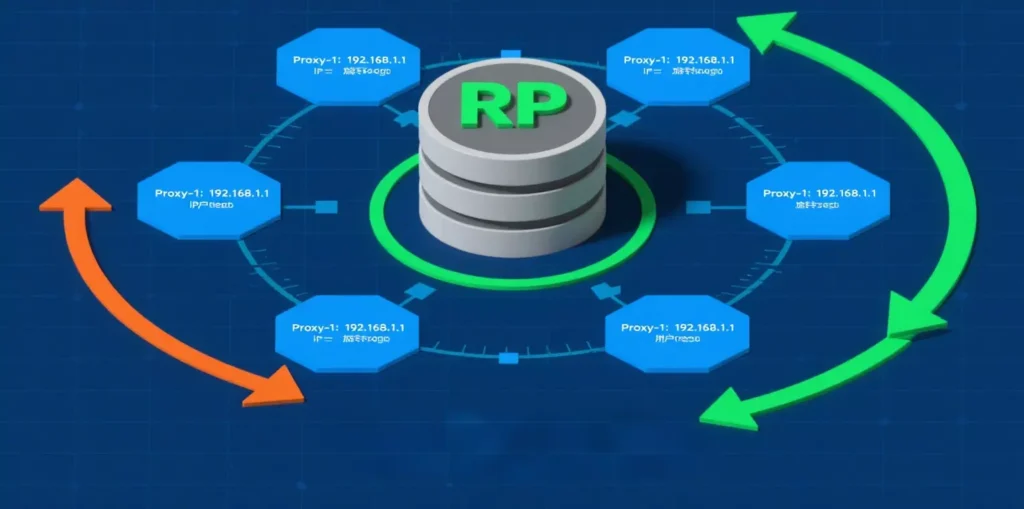In the world of web scraping, data analysis, and large-scale automation, the terminology can get complex. One term that often surfaces among advanced users is the “reverse rotating proxy.” While it sounds intricate, it represents one of the most powerful and efficient solutions for managing internet identity at scale. But what is it, how does it differ from a standard proxy, and who actually needs this cutting-edge technology?
This guide will demystify the concept of reverse rotating proxies, explain the powerful technology they represent—often known as backconnect proxies—and detail why they have become the gold standard for enterprise-level data operations in 2025.

First, Let’s Define the Components
To understand a reverse rotating proxy, you first need to understand its parts: the “reverse proxy” and the “rotating proxy.”
What is a Reverse Proxy? A traditional reverse proxy sits in front of a web server or a group of servers. Its job is to manage incoming traffic from the internet and distribute it to the correct backend server. Its primary functions are load balancing, security (acting as a Web Application Firewall), and caching to improve performance. You don’t use a reverse proxy to hide your identity; you use it to protect your servers.
What is a (Forward) Rotating Proxy? This is what most people think of when they discuss proxies for anonymity or web scraping. A rotating proxy service provides access to a large pool of IP addresses. It automatically assigns a new IP address to you on every request or after a set period. You use a rotating proxy to change your outgoing identity constantly.
The “Reverse Rotating Proxy” Explained: Meet the Backconnect Proxy
When people search for a “reverse rotating proxy,” they are almost always looking for a powerful type of forward rotating proxy known as a backconnect proxy. The name is confusing, but the concept is brilliantly simple from the user’s perspective.
Think of it with this analogy:
A standard rotating proxy is like being given a huge list of different P.O. boxes. For every letter you send, you have to pick a new P.O. box from your list to use as the return address.
A backconnect (or “reverse rotating”) proxy is like having a single, magical mailbox. You drop all your letters into this one mailbox, and it automatically assigns a different, random return address from a pool of millions for every single letter.
In technical terms, a backconnect proxy provides you with a single gateway address (e.g., gate.provider.com:port). You send all of your requests to this one address. The service on the backend then automatically “reverses” the connection and routes your request through one of millions of residential or mobile IPs in its network, rotating it with every request. You never see or manage the individual IP addresses—the system handles everything.
Key Advantages of Using a Reverse Rotating (Backconnect) Proxy
This architecture offers significant advantages for serious data operations:
1.Simplicity and Scalability:
You only need to configure one endpoint in your application or script. This single gateway gives you access to a potentially limitless pool of IPs, making it incredibly easy to scale your operations without complex configuration changes.
2.Enhanced Anonymity and Reduced Block Rate:
By rotating through a massive pool of high-quality residential IPs on the backend, the chances of being blocked or served a CAPTCHA are dramatically reduced. Your traffic appears to originate from thousands of different, legitimate users.
3.Effortless IP Management:
The proxy service handles all the hard work of IP health checks, rotation logic, and removing bad IPs from the pool. This frees up developers to focus on data extraction rather than proxy infrastructure management.
Who Needs This Technology? Top Use Cases
Reverse rotating proxies are not for casual use; they are a high-performance tool for demanding tasks:
Enterprise-Grade Web Scraping: Gathering product, pricing, or user data from heavily protected e-commerce and social media sites.
Large-Scale Market Research: Analyzing competitor websites, tracking consumer trends, and aggregating data from thousands of sources without being detected.
Ad Verification and Performance Monitoring: Ensuring that digital ads are being displayed correctly across different geographic locations and to different user profiles.
SEO Monitoring at Scale: Performing thousands of search engine queries from various locations to track keyword rankings accurately.
Choosing the Right Provider for Your Needs
The effectiveness of a backconnect proxy hinges entirely on the quality and size of the provider’s IP network. When selecting a provider, you need a network that is both vast and reliable. Leading services in this space, such as IPFLY, offer advanced backconnect rotating proxies that give users access to millions of residential IPs through a single, easy-to-use gateway. This combination of simplicity and power is what enables businesses to scale their data operations without getting bogged down by the complexities of IP management.

While the name “reverse rotating proxy” can be a source of confusion, the technology it describes—the backconnect proxy—represents the pinnacle of proxy solutions for large-scale data acquisition. By offering the simplicity of a single entry point with the immense power of a backend pool of rotating residential IPs, it solves the biggest challenges of modern web automation. For any business or developer serious about data in 2025, understanding and leveraging this technology is no longer an option, but a necessity.
Start now! Visit IPFLY.net to experience excellent proxy services and join the IPFLY Telegram community for the latest strategies—master cutting-edge tips and exclusive resources, and let proxies efficiently empower all your needs!


